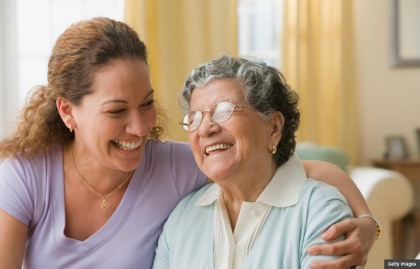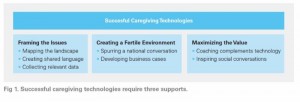Last year, I presented at a conference where the luncheon keynote speaker was the CEO of a non-profit hospital chain.
As we ate, the CEO excitedly shared how her organization was radically rethinking the delivery of medical care at all levels, including post-treatment convalescence.
She explained how more and more of their patients are convalescing at home, which means the patient is discharged as soon as possible after a surgical procedure. They recuperate at home under the care of family and friends with the support of periodic nursing visits, and remote monitoring.
She continued “we have found patients prefer this arrangement, and it has allowed us to dramatically reduce costs while continuing to provide high quality care. We, and other hospitals systems, see this as the model for the future.”
At that moment, all I could think was, “Hold the phone. Who exactly are these family members and friends who are now expected to oversee the recuperation and convalescence of their loved ones at home from often major surgical procedures? Does this CEO understand that most of these people work?”
So I raised my hand and asked the question. Not surprisingly, the CEO didn’t have an answer because that’s not her primary concern. The challenge this CEO is solving for is how to deliver the highest quality care to the most people in the most efficient and cost-effective way. On that dimension, she and other healthcare leaders are succeeding.
How can technology help us to deliver care on top of everything else we have to do, on and off the job?
This means that more and more of the burden to deliver all but the most acute level of care will fall to loved ones–family members and friends, most of whom will have to provide that often medically complicated care while continuing to hold down and perform at their paid job (70% of caregivers to be exact–Pew).
How is that sustainable?
With this question in mind, I jumped at an invitation from the National Alliance of Caregiving to participate in a unique day-long roundtable with twenty-two other experts from government, Silicon Valley, caregiving advocacy organizations, and researcher institutions this past April.
This diverse, committed group spent hours at the Institute for the Future offices in Palo Alto tackling these questions:
Until now, technology has made only modest contributions to supporting caregivers. Can technology play a more meaningful role in helping caregivers? And how can we accelerate innovation in developing new applications to support caregivers?”
The thought-provoking result of our collective effort can be found in the just-released report, “Catalyzing Technology to Support Family Caregiving” (and press release) and is synopsized in this model:
Create better “concept maps” and find more appropriate language to describe the varied and complex caregiving landscape. The way we currently talk about and think about caregiving is too simplistic. For innovation to occur, we need more accurate, complex models and maps of what caregiving actually entails.
Continue to collect extensive data about the prevalence, burden and impact of caregiving. Again, for technology to support the caregiver, we need more and better data showing the diversity of caregivers and growing complexity of caregiving responsibilities.
Spur a broad national conversation on caregiving. Quite simply–we need to talk about the growing challenge of the working family caregiver much more than we do. As we learned from our Silicon Valley colleagues, entrepreneurs won’t invest if there isn’t widespread attention on the topic because they don’t see the market, even though the market is huge.
Develop a compelling business case for employers and healthcare providers to support caregiving. In other words, help the leaders like the hospital CEO, and those that employ the increasingly overburdened family caregiver to understand the business case for offering smarter and better supports.
Inspire social conversations about caregiving to encourage more learning and support within families and communities. Basically, we aren’t talking to and supporting each other when we find ourselves knee deep in family caregiving responsibilities. How can we leverage and scale existing in person and virtual caregiver support models like CareGiving.com?
And last, but not least, the recommendation I am particularly passionate about because of the work I do with employees and employers…
Provide caregiving coaching as an integral component of all solutions.My main contribution to the dialogue was to point out that any technology solution developed to help the family caregiver has to be simple and usable. Also working caregivers need help learning how to fit that technology into all of the other, often chaotic, responsibilities they are frantically trying to manage, on and off the job.
How to make an “Intelligent Family Care Assistant” part of your work+life fit?
For example, one of the technology solutions the group proposed was called an “Intelligent Family Care Assistant,” a system to keep track of and coordinate the family’s care tasks.
The challenge, of course, remains what type of coaching does a family caregiver need to learn how to integrate that technology into their already busy work+life fit? And who would provide that coaching (e.g. hospitals, employers, doctors), and how (e.g. live, in-person, virtually)?
An exercise that the roundtable group completed gave me hope that we are close to knowing what that coaching model looks like and how to deliver it.
In this joint exercise, the group spent about 20 minutes identifying all of the activities and priorities a family caregiver has to deal with only once, then yearly, monthly, weekly, daily, nightly, etc. We wrote each priority and activity on a post-it note.
On pages 16-18 of the report, you will see pictures of post-it notes we then put into columns labeled labeled Medical, Wellness, Movement, Home, Social, Finance, Legal, Emotional and Personal Care, by level of frequency.
Essentially what the group did together in 20 minutes was complete a more complex version of the Tweak It Practice, with each post-it representing not only a “tweak” but also the inputs a caregiver would put into a care app like Unfrazzle. In other words, “contextualizing” coaching and support models like Tweak It and Unfrazzle exist, now it’s a matter of continuing to innovate and scale.
I hope you will take a few minutes to read the report and think about the recommendations. We all can help encourage the innovation required to support the growing ranks of family caregivers (one of which will likely be us someday).
What do you think? As always, we want to know. Share your thoughts with us Twitter @caliyost, Facebook and LinkedIn
Interested in new, cutting edge work+life fit technology solutions?
Learn more about our new, interactive Taking Control of Your Work+Life Fit e-learning curriculum for organizations. Programmed using Articulate’s Storyline, the curriculum’s modules are accessible to learners on demand from any desktop and mobile device. For more information, contact FSG/WLF’s Program Development Director, Linda Cannilla at linda@flexstrategygroup.com.



